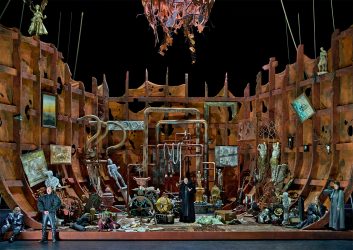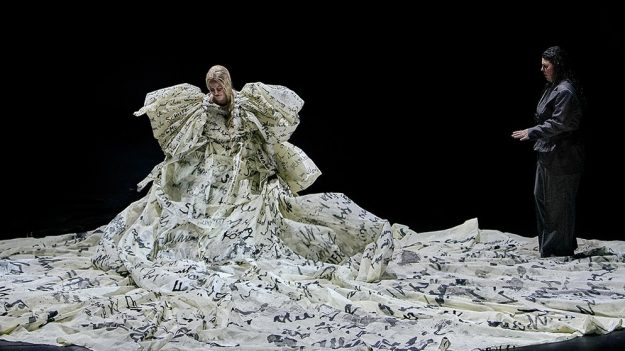
 Germany Bayreuth Festival 2024 [1] – Wagner, Tristan und Isolde: Soloists, Bayreuth Festival Chorus and Orchestra / Semyon Bychkov (conductor). Recorded live (directed by Michael Beyer) at the Bayreuth Festspielhaus, 25.7.2024. (JPr)
Germany Bayreuth Festival 2024 [1] – Wagner, Tristan und Isolde: Soloists, Bayreuth Festival Chorus and Orchestra / Semyon Bychkov (conductor). Recorded live (directed by Michael Beyer) at the Bayreuth Festspielhaus, 25.7.2024. (JPr)

Forgive a trip down memory lane but I first went to Bayreuth almost – but not quite – four decades ago and a highlight of those early idyllic days were not only the operas but the interval suppers with Wolfgang and Gudrun Wagner, family (including latterly a young Katharina) and other friends. My visits were increasingly frequent until the world shut down because of the pandemic. That and the earlier heightened security for various reasons in 2016, as well as tempus fugit means my time standing atop the Green Hill is becoming a distant memory. Thankfully I can still keep in touch with new productions through these livestreams from STAGE+.
Why look back? Well, one feature of my first visits to Bayreuth was how unforgiving the audiences were to singers giving less than stellar performances. Booing – and I am not advocating anybody should be ‘booed’ ever – is now mostly limited to the production team on the first night of anything new. While it seems the most unsatisfactory of musical performances these days raises the roof of the Festspielhaus.
I know I am reviewing a recording and my colleague Mark Berry will report soon on hearing this new Tristan und Isolde live, but I remain confident in what I saw and heard. On this occasion I heard Andreas Schager as Tristan run out of vocal stamina long before the end of his Act III ravings; even though he still had the physical energy to thrash around onstage. Schager had sung relentless very loud for most of the performance and while some of his softer singing had much to commend it that was the exception rather than the rule. Equally Camilla Nylund as Isolde – who may not have the volume for the role anyway – was throwing her head back and often singing louder than lovely. I don’t think this was a fault of Semyon Bychkov’s singer-friendly, passionate account of a score rich in orchestral colour, though he seemed to be accompanying what was happening on the stage rather than bringing thrust and impetus to the drama. The worst thing was that this can belto – and very mannered (watch Nylund and Günther Groissböck) – singing distracted from the nuanced acting the cast were capable of when not singing. Absolved of all criticism was Christa Mayer who melded empathetic and concerned acting with a rich, intense and expressive mezzo-soprano.
So, this was another new Tristan with Roland Schwab’s 2022 production having been swiftly replaced for some reason. It is directed by Icelandic theatre director Thorleifur Örn Arnarsson (with stage designs from Vytautas Narbutas) and seems to hark back to previous Bayreuth Tristans from Wieland Wagner (I know only from photos), Heiner Mϋller’s 1995 wasteland and Christoph Marthaler’s 2005 ship’s lower deck (both of which I did see several times). What we get from Arnarsson might have been more provocative had it had more coherence and dramatic cogency.
There are elements of rigging with ropes hanging down onto the stage and characters wander through much dry ice and remain on the very dark stage for most of the first act. Sibylle Wallum’s costumes are relatively plain throughout the opera, mostly greys or black with some leather (or pleather?). This is apart from Isolde who is in a voluminous – and I mean huge! – wedding dress (completed by a blinged-up headpiece) on which with a quill she seems to be scribbling words from the libretto and adding to those it is covered in. Few in the Festspielhaus would realise that is what she is doing even if they were in the first few rows. Her huge train is a significant leitmotif of this staging and reappears over the three acts and is something referred to by the characters as if it recounts the ongoing story. Otherwise, Isolde often has puffed sleeves which gives her the appearance of an avenging angel. There is no potion drunk from a goblet just a small bottle which is cast aside unopened when Tristan and Isolde’s eyes finally meet (they have been mostly singing out into the audience) and their fate is sealed. At the end of the act a chasm appears centre stage and the lovers peer down through it to the deck below.

For Act II we appear to be in the engine room of a wrecked ship, full of Isolde’s (?) piled-up belongings being taken to her new life in Cornwall. Is that a photo of her younger self Isolde looks longingly at? There is also a large globe, statues, stuffed animals, skeleton, clocks, books, newspapers, empty picture frames, as well as a Casper David Friedrich painting, amongst much else. There are small lighting bars within this detritus which will be covered or uncovered during the act. Tristan and Isolde are often on different sides of the stage and especially at the start of ‘O sink’ hernieder, Nacht der Liebe’ which heralded some of the better singing of this performance. There is much staring into one of the picture frames which I didn’t realise wasn’t an empty one – but supposedly a mirror – only when Tristan smashes his hand through it. Though Tristan brandishes a sword and cuts his hand at one point there is no swordfight with Melot and Tristan drinks from the bottle of potion and collapses.
Finally for Act III I wonder whether the ship has now beached as we get the ropes and dry ice as in the first act along with some of the stuff from the second. The Shepherd has an interesting shaggy white coat while Tristan’s shirt and trousers are written on now and he will also write on his own arm at one point. Tristan sings about ‘That evil wound’ which is more mental than physical because for Arnarsson it is all about the ‘Accursed drink’ and near the end he introduces a Romeo and Juliet moment as Isolde tries to drink from the empty poison bottle. King Marke may sing ‘Tot denn alles!’ however there is no fighting and nobody is dead apart from Tristan, with everyone (again) sitting or standing about. Nylund begins her Liebestod und Verklärung gently and quietly on the floor of the stage and ends it ravishingly as if carried through it on waves of emotion before sinking down again.
I thought Olafur Sigurdarson was miscast as Kurwenal; he was too bluff and straightforward for my liking and has a rather rough-textured, stentorian baritone voice. Günther Groissböck wore a black sparkly Astrakhan overcoat and gave a rather odd Baron Ochs-like rendition of King Marke’s Act II narration, satisfactory yet not particularly memorable whilst strangely uncomfortable to watch in close-up at times. At his second interval curtain call Groissböck actually did suffer some booing but not at the end. Completing the cast there were excellent vignettes from Birger Rådde (Melot), Daniel Jenz (Shepherd), Lawson Anderson (Steersman) and Matthew Newlin (Young Sailor).
So, make of all this what you will though maybe with Werkstatt Bayreuth Arnarsson’s Konzept will coalesce better in coming years for those privileged to be there.
Jim Pritchard
Featured Image: Bayreuther Festspiele 2024 – Camilla Nylund (Isolde) and Christa Mayer (Brangäne) © Enrico Nawrath
Production:
Director – Thorleifur Örn Arnarsson
Stage design – Vytautas Narbutas
Costume – Sibylle Wallum
Lighting – Sascha Zauner
Dramaturg – Andri Hardmeier
Chorus director – Eberhard Friedrich
Cast:
Tristan – Andreas Schager
Isolde – Camilla Nylund
King Marke – Günther Groissböck
Kurwenal – Olafur Sigurdarson
Melot – Birger Rådde
Brangäne – Christa Mayer
A Shepherd – Daniel Jenz
A Steersman – Lawson Anderson
Young Sailor – Matthew Newlin
